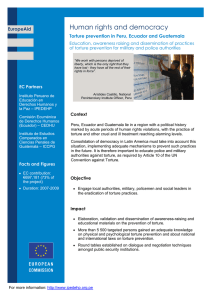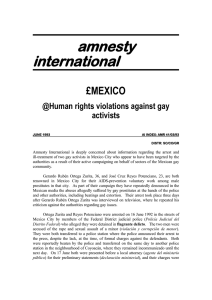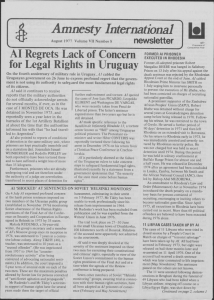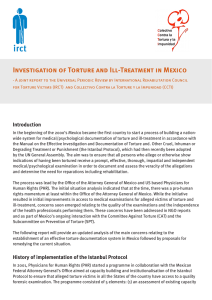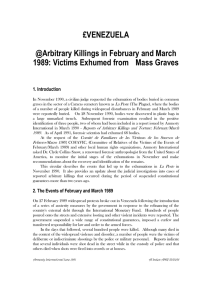£URUGUAY @Torture and ill-treatment after six years of civilian rule
Anuncio
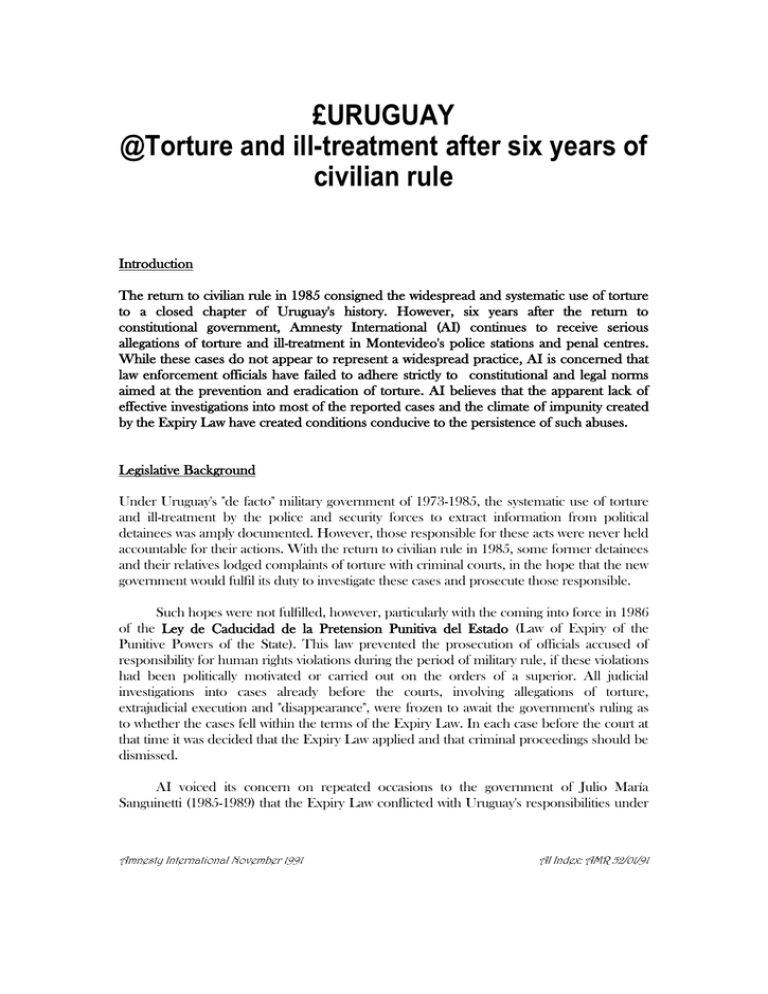
£URUGUAY @Torture and ill-treatment after six years of civilian rule Introduction The return to civilian rule in 1985 consigned the widespread and systematic use of torture to a closed chapter of Uruguay's history. However, six years after the return to constitutional government, Amnesty International (AI) continues to receive serious allegations of torture and ill-treatment in Montevideo's police stations and penal centres. While these cases do not appear to represent a widespread practice, AI is concerned that law enforcement officials have failed to adhere strictly to constitutional and legal norms aimed at the prevention and eradication of torture. AI believes that the apparent lack of effective investigations into most of the reported cases and the climate of impunity created by the Expiry Law have created conditions conducive to the persistence of such abuses. Legislative Background Under Uruguay's "de facto" military government of 1973-1985, the systematic use of torture and ill-treatment by the police and security forces to extract information from political detainees was amply documented. However, those responsible for these acts were never held accountable for their actions. With the return to civilian rule in 1985, some former detainees and their relatives lodged complaints of torture with criminal courts, in the hope that the new government would fulfil its duty to investigate these cases and prosecute those responsible. Such hopes were not fulfilled, however, particularly with the coming into force in 1986 of the Ley de Caducidad de la Pretension Punitiva del Estado (Law of Expiry of the Punitive Powers of the State). This law prevented the prosecution of officials accused of responsibility for human rights violations during the period of military rule, if these violations had been politically motivated or carried out on the orders of a superior. All judicial investigations into cases already before the courts, involving allegations of torture, extrajudicial execution and "disappearance", were frozen to await the government's ruling as to whether the cases fell within the terms of the Expiry Law. In each case before the court at that time it was decided that the Expiry Law applied and that criminal proceedings should be dismissed. AI voiced its concern on repeated occasions to the government of Julio María Sanguinetti (1985-1989) that the Expiry Law conflicted with Uruguay's responsibilities under Amnesty International November 1991 AI Index: AMR 52/01/91 2 international standards1 to respect the right of families of the "disappeared" to know the fate of their relatives, to carry out a full investigation into human rights violations, to have the perpetrators brought to justice, and to be granted appropriate compensation.2 Bringing the perpetrators to justice is not only important in respect of the individual case, but sends a clear message that violations of human rights will not be tolerated and that those who commit such acts in the future will be held fully accountable. Legislation which grants immunity from prosecution to the security forces for human rights violations committed in the past contributes to a sense of impunity on the part of those responsible and thereby makes the recurrence of such practices more likely in the future. The Uruguayan Constitution guarantees the physical security of the individual and prohibits imposition of the death penalty. The crimes of torture, or attempts to commit torture, are not specified as offences in the Penal Code, though the 1975 law governing imprisonment prohibits the use of torture and other cruel, inhuman or degrading treatment against inmates. In the absence of legislation explicitly aimed at prohibiting and sanctioning all acts of torture, police officials can only be prosecuted for abuse of authority or injuries (lesiones). Abuse of authority against detainees (abuso de autoridad contra los detenidos) is punishable by between 6 months to 2 years in prison. Injuries inflicted by a public official (lesiones por funcionario público) are punishable by between 4 months and 8 years, or up to 10 years if the injuries inflicted are serious. Uruguay's constitutional and legal guarantees against torture are complemented however by international instruments which it has ratified. Uruguay has signed the Inter-American Convention to Prevent and Punish Torture and in 1986 it ratified the United Nations Convention against Torture and Other Cruel, Inhuman or Degrading Treatment or Punishment. Furthermore, the current administration of President Lacalle has taken steps towards ensuring compliance with these norms and guarantees. Human rights training 1 Such standards include the International Covenant on Civil and Political Rights and the United Nations Convention Against Torture and Other Cruel, Inhuman and Degrading Treatment or Punishment, as well as several resolutions adopted by the United Nations. 2 Despite the barrier to criminal prosecution created by the Expiry Law, the relatives of several people who died as a result of torture in custody during the military government obtained ex gratia compensation from the state following civil court rulings in their favour in l990. In lawsuits brought by another six former detainees for damages (daños y perjuicios), the Ministry of Defence offered in l990 to negotiate out-of-court settlements. While acceptance of these claims was seen as a tacit admission of the state's responsibility for illegal detention and torture in the past, the resolution of the claims through out-of-court settlements avoided stages in the proceedings in which members of the security forces would have been brought to testify and the alleged existence of clandestine detention centres during the period of military rule would have been investigated. Other former detainees whose claims are before civil courts have criticized these settlements for allowing the government to evade a thorough investigation and clarification of events, as well as a public and unequivocal admission of state responsibility. AI Index: AMR 52/01/91 Amnesty International November 1991 3 programmes for police personnel and prison workers have recently been introduced by the Ministry of the Interior. A course on the role of the police and the penitentiary system in the protection of human rights was given imparted in July 1990 by the United Nations Centre for Human Rights, in collaboration with the Ministry of External Relations. In early 1991 the Fiscalía Letrada de la Policía was established as a mechanism within the police force to monitor internal inquiries into abuses of authority and other illegal acts committed by police personnel. Torture and Ill-treatment in Police Custody The safeguards and measures described above have undoubtedly contributed to a greater respect for the physical safety and integrity of detainees. However, six years after the return to civilian rule, Amnesty International continues to receive serious allegations of torture and ill-treatment of criminal suspects at the hands of police in Montevideo. While these do not appear to represent a systematic and widespread practice, AI is concerned that the restoration and reinforcement of constitutional guarantees has been insufficient to achieve the eradication of torture and ill-treatment. One of the fundamental reasons, AI believes, is the apparent lack of effective investigations into most of the cases reported. This only serves to reinforce the sense of impunity created by the Expiry Law, which may have given certain elements within the security forces the impression that such practices are acceptable. The police detention centres most frequently implicated in allegations of torture are the Jefatura de Policía de Montevideo, the Montevideo Police Headquarters, and the Comisarías (police stations) of the Seccionales de Policía (police sections) covering the poorer neighbourhoods of Montevideo where the crime rate is high. The majority of detainees who have presented judicial complaints alleging torture or ill-treatment in police custody are working class men between 16 and 30 arrested on suspicion of petty crimes. Of particular concern is the fact that some of the cases reported to AI involve detainees who were under 18 years old at the time of their arrest. According to detainees' testimonies, the types of ill-treatment to which they are subjected include severe beatings, sometimes with batons; near asphyxiation by hooding; electric shocks; injuries to the testicles and being threatened with further torture or death. At least two detainees have died in police custody since 1989 in disputed circumstances. Construction worker Guillermo Machado was arrested on 16 July 1989 and taken to the Comisaría de la Seccional 15a. He was about to be released hours later but was kept in detention following an altercation with the officer in charge over the return of his personal belongings. That evening he was found unconscious in his cell. He died in hospital a week later. During an inquiry into the death, police officers testified that Guillermo Machado had attempted suicide by hanging himself with his sweater. The officer responsible for holding him was prosecuted for illegal arrest (in relation to the period of detention Amnesty International November 1991 AI Index: AMR 52/01/91 4 following the altercation), but was not convicted. In August 1989, Jorge Inciarte Castells died while in detention at the Comisaría de la Seccional 1a. Police stated that he had hanged himself with his trousers. However, witnesses said that Jorge Inciarte had been beaten severely on arrest and though he had been bleeding profusely, had been denied medical attention. Despite the presentation of further evidence to the courts by witnesses, the circumstances of his death have not been fully clarified and no-one has been prosecuted in relation to the alleged ill-treatment. The deaths of Guillermo Machado and Jorge Inciarte in 1989 prompted large-scale public protests against ill-treatment and arbitrary arrest by the police. Thousands of people demonstrated against the police practice of conducting razzias (sweeps) in certain neighbourhoods of Montevideo, in the course of which young people would be arbitrarily detained in the streets and held for questioning for up to 24 hours. Many of those detained in razzias alleged they had undergone physical and psychological ill-treatment. The wave of protests led to the suspension of razzias at the end of 1989 and to the resignation of the then Minister of the Interior. Summaries of several cases of torture and ill-treatment in police custody reported since President Lacalle took office in March 1990 are presented in the Appendix. As AI has only documented cases in which a complaint was made by the detainee before a judge, this selection of cases may not give an accurate indication of the extent of the use of torture and ill-treatment. Amnesty International has information to suggest that many detainees who are subjected to ill-treatment do not present a formal denunciation before the courts out of fear of reprisals and mistrust of the administration of justice. To Amnesty International's knowledge, none of the judicial proceedings initiated into the cases described in the Appendix has so far resulted in the identification and prosecution of those responsible. AI has recently been informed by human rights lawyers working on the cases that the majority were temporarily closed (archivados) after the initial pre-sumario stage, apparently due to lack of evidence. AI understands, however, that in these cases considerable evidence had been presented to the court, including forensic and other medical reports recording injuries suffered as a result of the ill-treatment. Though the Code of Penal Procedure makes clear that it is the duty of the Ministerio Público (Public Ministry) to ensure that investigations into allegations of torture are pursued, to Amnesty International's knowledge, proceedings have not been initiated against any of the officers identified by the detainees in the cases below. Amnesty International has noted that investigations in a small number of other cases of alleged ill-treatment in police custody have resulted in the arrest of the police officers responsible. For example, a sergeant and two officers of the Dirección de Investigaciones were convicted of "abuse of their functions prejudicial to the detainee" (abuso de funciones con prejuicio al detenido) after a judicial complaint was filed against them by Luis Fernández AI Index: AMR 52/01/91 Amnesty International November 1991 5 Greno, who alleged having been tortured with electric shocks while in police custody in February 1991, to such an extent that he had to be hospitalized. Following this and other incidents involving alleged abuse of authority by the police in the first two months of 1991, the Minister of the Interior, Juan Andrés Ramírez, announced the establishment of the Fiscalía Letrada Nacional de Policía to monitor internal administrative proceedings against police accused of committing illegal acts. Sr. Ramírez also announced major changes to the police hierarchy, reportedly prompted by the failure of certain police authorities to comply with orders that all interrogations be carried out in the presence of a senior police official. These measures, together with the arrest and conviction of police accused of human rights violations, give an important signal that such abuses are intolerable. Amnesty International also welcomes Sr. Ramírez's affirmation in March this year of the government's resolve to punish any police officer who acts outside the law: "Neither the Ministry, nor the hierarchy, nor the chiefs of police will on any occasion cover up for officials who act outside the law and whenever these are discovered measures will be taken with the greatest determination."3 (Report to the Security Commission of the Legislative Chamber, March 1991). The apparent lack of thorough and conclusive investigations into most of the recent allegations of torture and ill-treatment, however, raises questions about the government's stated resolve to show that such police abuses will not go unpunished. Moreover, the disturbing statements made earlier this year by the former Minister of Defence, retired general Hugo Medina, in which he appeared to condone the use of torture under the military government, serve to reinforce the need to show that torture will never be tolerated. This can only be done effectively by bringing to justice those responsible. Alleged Ill-treatment in Prison AI has also been concerned about allegations of ill-treatment which have emanated from certain prisons since 1990, particularly the maximum security prison Libertad, near Montevideo. In 1990 several prisoners in Libertad died in disputed circumstances. Among them was Jorge Barreiro Dorta, who was found hanging in his cell on 14 February. His cell-mate testified before a court that Jorge Barreiro had been ill-treated by prison guards shortly before his death. His death provoked a hunger strike by prisoners protesting against ill-treatment and harsh conditions in the prison. In July 1990, relatives of prisoners in Libertad claimed that scores of prisoners were beaten during a cell search by prison guards, 3 Ni el Ministerio, ni las jerarquías, ni los jefes de Policía en ningún momento van a encubrir a los funcionarios que actúen al margen de la ley y en caso de descubrirlos se van a tomar las medidas con el máximo empeño." Amnesty International November 1991 AI Index: AMR 52/01/91 6 carried out shortly after a number of prisoners attempted to escape from Libertad. A delegation from the Supreme Court of Justice visited Libertad in November 1990 to investigate complaints of ill-treatment made by prisoners and their families. The delegation reportedly took statements from the prisoners and some of the reports of ill-treatment were said to have been presented to a judge. In December 1990, AI wrote to the Minister of the Interior requesting to be informed of the results of the visit. AI requested further information from the government regarding any legal proceedings initiated in relation to these judicial complaints, and asked whether as a result of these investigations, measures had been taken to ensure that the security and physical integrity of the prisoners was respected. AI received no response to its inquiries. It understands, however, that following recommendations from the Grupo de Trabajo sobre el Sistema Nacional Penitenciario, the Working Group on the National Penitentiary System (made up of representatives of legal, human rights and other non-governmental organizations), the Minister of the Interior ordered the dismissal of the then Director of Libertad and appointed a group of experts to study and monitor prison conditions. However, none of the cases of prison deaths in disputed circumstances appear to have been judicially resolved or clarified. AI has learned with interest that, following a decision by the Supreme Court after its visit to the prison, cases of deaths in prison are to fall immediately under the jurisdiction of the justicia letrada of the department of San José, rather than be handled by the justice of the peace nearest the prison, and that autopsies in such cases are to be carried out by the Instituto Técnico Forense, the Forensic Technical Institute, as opposed to a non-specialized police doctor. The reported suicide in February and May 1991 of two boys, aged 15 and 16, in the Cárcel de Miguelete, a prison for violent young offenders, drew attention to the alleged inhuman conditions there. Cárcel de Miguelete, built as a maximum security prison, was reopened by the governmental Instituto Nacional del Menor (INAME) in December 1990 and one wing of it was renovated to hold young offenders. Uruguayan human rights groups have described conditions in the prison as totally unsuitable for the rehabilitation and reeducation of young offenders. Rafael Berón Charquero, aged 16, was sent to Miguelete on 10 February on charges of sexual harassment of his two younger sisters. His fellow inmates claimed that on his first day he was beaten twice and suffered several attempts at rape. It is not clear whether prison guards participated in these acts, though it appears nothing was done by the wardens to prevent them. The next day, he apparently attempted to commit suicide and was found hanging in his cell, still conscious. He was taken to hospital, where he died after two weeks in a coma. An autopsy revealed severe bruising and cuts on his body, as well as signs of attempted rape. AI Index: AMR 52/01/91 Amnesty International November 1991 7 To Amnesty Internationals knowledge, there has been no investigation into Rafael Charquero's death, nor have measures been taken to guarantee the physical safety of minors in Miguelete, despite reports of another suicide and an attempted suicide there in May. Conclusion While torture and ill-treatment do not appear to be widespread practice in Uruguay, Amnesty International has continued to receive well-founded and serious allegations of torture and ill-treatment by some law enforcement officials in Uruguay. The organization is concerned that under the current administration of President Lacalle, the authorities appear to have failed to bring to justice those responsible for such abuses and fears that the lack of effective investigations into the cases reported will only reinforce the sense of impunity which was created by the Expiry Law and which may encourage the persistence of these practices. Amnesty International believes the Uruguayan government should implement an effective programme for the total eradication of torture, so as to fulfil its stated resolve to show that such practices will not be tolerated. APPENDIX Selected Recent Cases of Reported Torture in Police Custody Adrian Marcel Lombardo According to a complaint presented to the courts, he was arrested on 21 March 1990 and taken to the homicide department of the Jefatura de Policía (Police Headquarters) in Montevideo. There he was hooded, stripped and handcuffed, and questioned in connection with a murder. He was made to lie on some wet rags and given electric shocks to different parts of the body. The following day he was released. Alberto Píriz Medina According to a complaint submitted to the Juzgado de lo Penal de 7o Turno he was arrested on 3 August 1990 and taken to the Comisaría de la Seccional 5a, Montevideo, stripped naked and beaten on both ears with the palms of the hands, as well as on the chest. Amnesty International November 1991 AI Index: AMR 52/01/91 8 Police asked for money to leave him alone. He was held for 28 hours, beyond the legal limit, and his request to be taken before a judge was refused. At the end of the year he was still reportedly suffering from partial deafness resulting from the beatings. Investigations reportedly were closed in April 1991 and the case was provisionally closed (archivado), in spite of the fact that a forensic doctor's report recorded his injuries. Ricardo Costa, Vicente Vinagre and Nestor Moreira According to the complaint presented to the Juzgado Penal de 11º Turno, these three workers at the SEVEL metallurgy factory were arrested at their place of work on 31 August 1990 and taken to the Jefatura de Policía in Montevideo. There they were hooded, insulted, threatened, and beaten on the stomach, back, testicles and arms. They were released the same day and told that they had been arrested by mistake. Ricardo Fabra Riverol On 5 January 1991 Ricardo Fabra Riverol was walking along a street with an acquaintance in the neighbourhood of La Cruz de Carrasco in Montevideo when a shot was fired at them. His companion ran off, but Ricardo Fabra was arrested by three armed policemen dressed in plainclothes, one of whom he recognised as an officer who lived in his neighbourhood. He alleged he was kicked and violently forced into a vehicle. On the way to the Jefatura de Policía, he was beaten repeatedly, threatened and insulted. He was warned that if he did not collaborate and give information about the person he had been walking with down the street he would be subjected to the picana (torture with electric shocks). The injuries, mainly bruising, he sustained as a result of the beatings were recorded in a certificate issued by a local doctor. A formal complaint was presented to the Juez Letrado de 1a Instancia en lo Penal de 8vo Turno on 9 January 1991. Guillermo Alejandro Belsito Luna and Diego Washington Martínez Rancel According to the complaint submitted on their behalf to the Juez Letrado de Primera Instancia en lo Penal 8vo Turno, the two youths, both aged 16, were waiting for a bus in central Montevideo on 6 January 1991 when they were arrested by three policemen who asked for their identity documents. As they didn't have their documents on them, they asked if they could go home and get them. When Diego Martinez insisted that he only lived two blocks away, the policemen hit the two of them, twisted their arms, grabbed them by the hair and forced them into a vehicle. Once at the Comisaria de la Seccional 9a, Guillermo Belsito Luna was insulted, beaten all over his body, particularly injuring his arm. He was locked up alone in a dirty cell. Relatives of the two who were called to collect them late at night noted their poor physical condition. Police initially refused a request that the two be examined by a forensic doctor but agreed when the detainees insisted. AI Index: AMR 52/01/91 Amnesty International November 1991 9 Fabiana Carla Maidana (22), Julio Correa (18) and Alejandro Maidana (17) Julio Correa and Alejandro Maidana were arrested by police in a Montevideo street in the early hours of the morning of 9 January 1991. The two were taken, with two other detainees, to the Comisaría de la Seccional Primera de Policía, where Julio Correa was reportedly punched in the face, his jumper placed over his head like a hood, and he was turned around continuously to make him dizzy. He was thrown down on a wet floor, handcuffed and dragged by the handcuffs across the floor, and told to "confess". At one point he was threatened he would be killed. Alejandro Maidana was beaten with a rubber baton on the shoulder and neck, kicked in the mouth and other parts of the body, and his testicles pulled, causing him intense pain. When his sister, Fabricia Maidana went to the police station to find out what had happened to him, she too was arrested and a woman was ordered to beat her. She did not do so when Fabricia threatened to report what had happened to the other detainees. She claimed she was then taken to watch her brother being beaten. All three were released that morning and the two men subsequently examined by a forensic doctor on the orders of a judge. A complaint, naming the sergeant responsible for the ill-treatment, was submitted to the Juez Letrado de Primera Instancia en lo Penal de Tercer Turno. Amnesty International November 1991 AI Index: AMR 52/01/91
